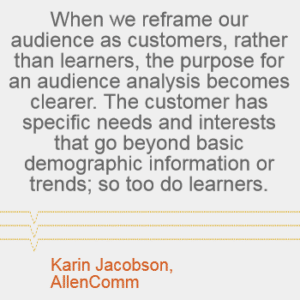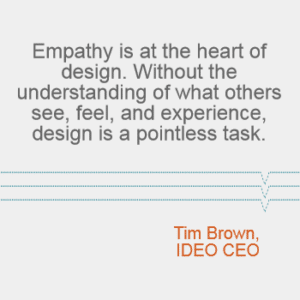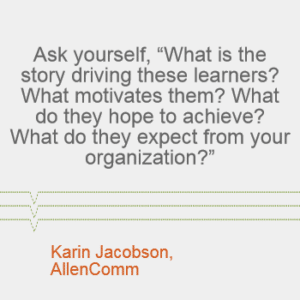How to develop empathy for your audience—and why you should
You’ve started with the end in mind and now have a set of clearly defined metrics that link with your company’s business objectives. You know if the project succeeds, it will make a measurable impact on the company’s bottom line.
But how do you connect those high-level objectives with your learning design? The missing link is your learners.
The traditional approach to learner analysis
Learner analysis isn’t a new concept for instructional design. It’s the starting point for many traditional instructional design models, such as ADDIE. Designers often begin the analysis with a series of demographic and background questions such as:
- Who will enroll in the course/training?
- How large is the audience?
- Where are they located?
- What job positions do audience members hold?
- What is their educational experience and background?
- What expectations will learners have with regard to time and amount of work?
- What hardware, software or other equipment will the learners have?
 Questions like these are great for defining the general scope of a project. However, they don’t always provide the details necessary to create a training experience that changes learners’ hearts and minds (and behavior). When we reframe our audience as customers, rather than learners, the problems with this demographic approach to learner analysis become more obvious. For example, consider the following two taglines for cars ads:
Questions like these are great for defining the general scope of a project. However, they don’t always provide the details necessary to create a training experience that changes learners’ hearts and minds (and behavior). When we reframe our audience as customers, rather than learners, the problems with this demographic approach to learner analysis become more obvious. For example, consider the following two taglines for cars ads:
“Power has met its hatch” (for the VW GTI)
and
“Spark Your Sense of Adventure” (for Toyota Tacoma trucks)
The stories and emotions underlying these taglines are obviously very different because they are aimed at different audiences with different needs and interests. Marketers know the importance of knowing the target audience.
When we reframe our audience as customers, rather than learners, the purpose for an audience analysis becomes clearer. The customer has specific needs and interests that go beyond basic demographic information or trends; so too do learners.
How do you create a training program tailored specifically for a particular audience? It requires empathy.
Why is empathy important?
 According to IDEO CEO Tim Brown, “Empathy is at the heart of design. Without the understanding of what others see, feel, and experience, design is a pointless task.” Although he is talking about design thinking, his point applies equally well to instructional design—after all, instructional design is design.
According to IDEO CEO Tim Brown, “Empathy is at the heart of design. Without the understanding of what others see, feel, and experience, design is a pointless task.” Although he is talking about design thinking, his point applies equally well to instructional design—after all, instructional design is design.
Without empathy, we can’t understand learners’ emotions, and emotion is the fundamental driver of human behaviors. In fact, neuroscientists such as Dr. Jill Bolte Taylor, author of the best-selling My Stroke of Insight, argue that emotion is more important to behavior than reason. In her book, Taylor says, “Sensory information streams in through our sensory systems and is immediately processed through our limbic system. By the time a message reaches our cerebral cortex for higher thinking, we have already placed a ‘feeling’ upon how we view that stimulation—is this pain or is this pleasure? Although many of us think of ourselves as thinking creatures that feel, biologically we are feeling creatures that think.”
Dana Mitroff Silvers at Design Thinking for Museums explains it this way, “We start with the needs of individuals because designing for individual needs often leads to greater insights and inspiration. The best solutions come out of the best insights into human behavior. When we design for average users, we may make incremental (but certainly valid and important) improvements to existing products, services, or experiences, but we typically won’t end up with radical insights, innovative game-changers, or re-definitions of complex, messy problems.”
What are some specific techniques instructional designers can use to develop empathy?
 Your primary goal in an audience analysis is to develop a strong connection with the learner as an individual, rather than a job role. Take the perspective of an anthropologist, observing learners in their natural settings to capture what they see and hear. This goes beyond a task analysis to a deep understanding of what learners are thinking, feeling and experiencing. Ask yourself, “What is the story driving these learners? What motivates them? What do they hope to achieve? What do they expect from your organization?”
Your primary goal in an audience analysis is to develop a strong connection with the learner as an individual, rather than a job role. Take the perspective of an anthropologist, observing learners in their natural settings to capture what they see and hear. This goes beyond a task analysis to a deep understanding of what learners are thinking, feeling and experiencing. Ask yourself, “What is the story driving these learners? What motivates them? What do they hope to achieve? What do they expect from your organization?”
Here are a couple of techniques you can use to develop more empathy for your learners:
1. Empathy Interviews
What it is?
According to UBC d.studio, empathy interviews are used to find out as much as possible about a person’s experience as a user of a particular process, space or environment. Instructional designers can use these interviews as a supplement to task analysis
How it works.
Conduct these interviews in a comfortable setting using open-ended interviewing. Work in pairs, with one person serving as the interviewer and the other as the documentarian. Include the following techniques in your interviews:
- Ask why. Even if you think you know the answer, ask why. Then really listen for the answer.
- Always ask for specific examples, rather than general information. For example, use this as a starter: “Tell me about a time when…”
- Encourage stories. Stories show learners’ motivations and perceptions about the world.
- Look for inconsistencies in learners’ stories. These tension points may be where the training can make the most impact.
- Design Thinking for Museums recommends you document what you see (i.e., the interviewee’s body language, setting, what they are using, etc.), what you hear (quotes, stories, contradictions), what the user feels (emotions, beliefs, confusion)
Go here for more guidance on conducting empathy interviews.
2. Customer/Learner Journey Map
What is it?
A Customer or Learner Journey Map (also known as A ‘Day in the Life’ Journey Map) helps you tell the story of a learners’ work day. It identifies the key activities the learner performs and the feelings, motivations and questions learners experience during each of these activities. Journey maps can take many forms, but they’re often presented as infographics. Go here for an example.
How it works.
Begin by choosing a small number of learners (no more than 20) representing the learner attributes that are most important to you (be sure to include a cross section of your learner population). Select a data-gathering technique that will provide you with data taken while your learners are working. Examples include:
- Observations and interviews while the learner is in the middle of the experience.
- Photo diaries or videos that learners capture throughout the day.
Using the data you’ve gathered, draw a timeline that represents your learner’s day. With Post-it notes, capture the most important insights gathered at each point on the learner’s daily journey. Be sure to include emotions, pain points and stories.
In Designing for Growth: a design thinking tool kit for managers, Jeanne Liedtka and Tim Ogilvie offer this tip: “You are looking for the emotional highs and lows and the meaning that the experience holds for the [learner].” Remember that the purpose isn’t to generate statistically significant results. Instead, it’s to gain creative insights about learners needs and motivations that aren’t available through other methods.
For more ideas of empathy-generating techniques, check out these resources. With a more detailed understanding of the needs, emotions and stories that motivate your learning audience, you have the information necessary to develop a game-changing training program. Now it’s time to map your learner insights to impactful training activities—targeting emotion as well as reason. And finally, link these activities back to the business-changing metrics you identified when you started with the end in mind.






Comments 1
May I simply just say what a relief to find a person that genuinely understands what they’re talking about on the net.
You certainly know how to bring an issue to light and make it important.
More people have to check this out and understand this side of your story.
I can’t believe you aren’t more popular because you definitely possess
the gift.